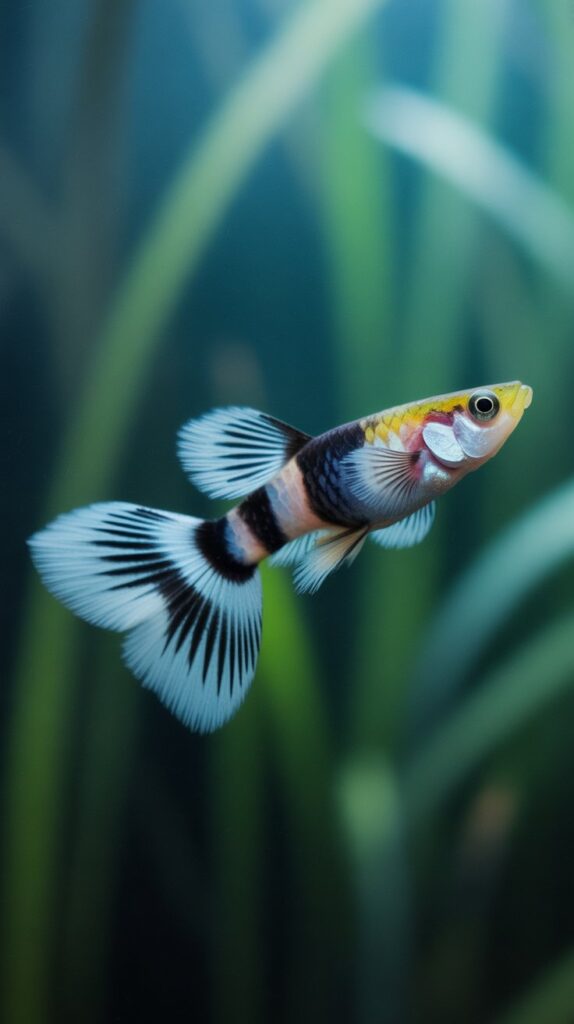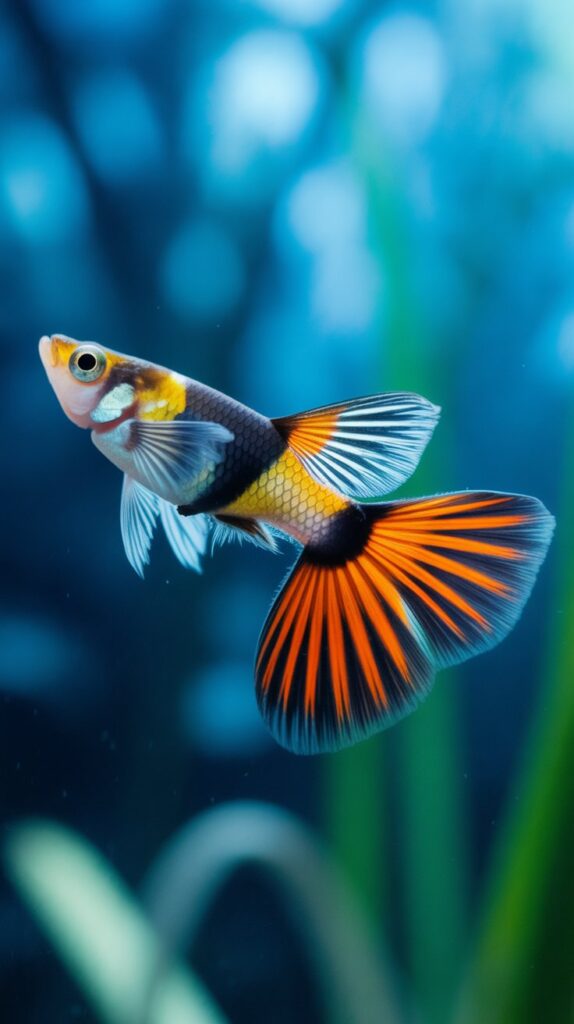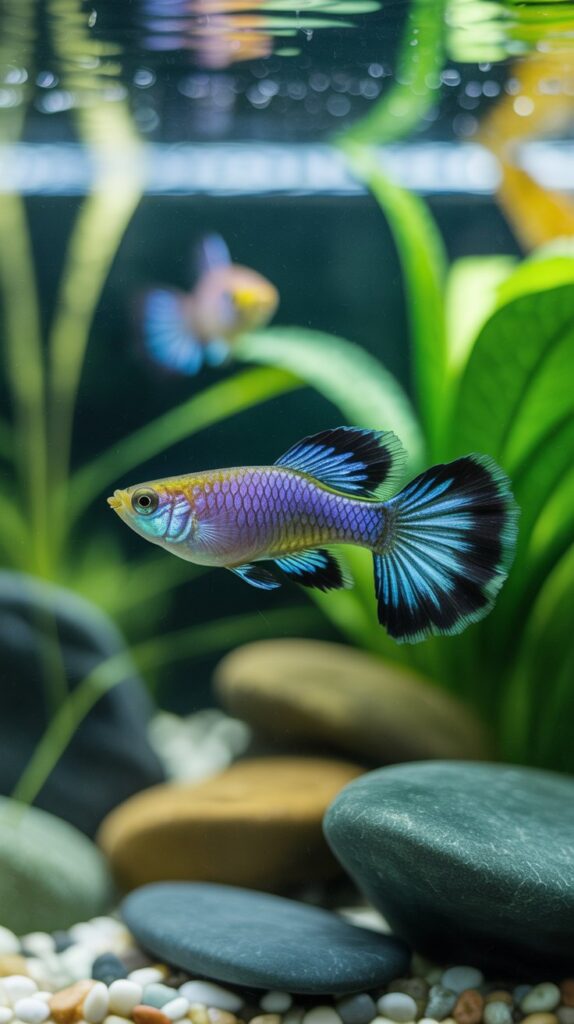The Velvet Guppy is an exquisite ornamental fish cherished by aquarists around the globe. With its soft, satin-like sheen, graceful movement, and dazzling colors, this guppy variety captures attention in any freshwater aquarium. Whether you’re a beginner looking to start a guppy tank or an experienced aquarist searching for unique additions, the Velvet Guppy is an ideal candidate. This comprehensive, SEO-optimized, and human-written guide covers everything you need to know about Velvet Guppies—including origin, appearance, tank requirements, feeding, breeding, and more.
Overview of the Velvet Guppy
- Scientific Name: Poecilia reticulata
- Common Name: Velvet Guppy
- Family: Poeciliidae
- Origin: Selectively bred from wild guppies
- Lifespan: 2–3 years
- Adult Size: 1.5 to 2.5 inches
- Temperament: Peaceful
- Diet: Omnivorous
- Tank Level: All levels
The Velvet Guppy gets its name from its smooth, velvety coloration that often features a rich blend of deep blues, purples, blacks, or reds. These fish are bred for their aesthetic appeal and are highly sought after by guppy enthusiasts.
Appearance and Color Variations

Velvet Guppies come in a variety of color forms, each reflecting a unique texture reminiscent of velvet fabric. Some of the most popular variants include:
- Black Velvet Guppy – Deep, inky black coloration with minimal patterning.
- Blue Velvet Guppy – Shimmering dark blue scales with a metallic or velvety texture.
- Red Velvet Guppy – Rich crimson or burgundy hues with a soft, luxurious look.
- Purple Velvet Guppy – An exotic purple tinge that appears soft and royal.
- Velvet Moscow Guppy – A combination of velvet hues with Moscow guppy genetics for enhanced body color.
Their tails may be delta-shaped, round, fan, or even sword-like, depending on their breeding line. Males tend to be more colorful and have more defined tail shapes compared to the females.
Origin and Genetics
Velvet Guppies are not found in the wild; they are a result of selective breeding. Breeders have carefully developed this line by enhancing recessive and dominant genes responsible for pigmentation, tail shape, and body texture. Most Velvet Guppies are derived from Moscow, Tuxedo, or Snakeskin lineage combined with pigmentation genes for enhanced depth of color and a matte or satin-like texture.
Temperament and Behavior
Velvet Guppies are:
- Friendly and non-aggressive
- Very active swimmers
- Often interact with tank mates and owners
- Ideal for community aquariums
Because of their peaceful disposition, they pair well with other small, non-aggressive fish such as mollies, platies, tetras, rasboras, and Corydoras catfish.
Ideal Tank Setup for Velvet Guppies

Setting up the perfect home for Velvet Guppies involves attention to water quality, lighting, and tank aesthetics.
Tank Size
- Minimum: 10 gallons (for a small group)
- Ideal: 20 gallons or more for breeding colonies
Water Parameters
- Temperature: 72°F–82°F (22°C–28°C)
- pH: 6.8–7.8
- Hardness: 8–12 dGH
- Ammonia/Nitrite: 0 ppm
- Nitrate: Below 20 ppm
Filtration & Aeration
- Use a gentle filter (like sponge or hang-on-back)
- Maintain steady water flow and oxygenation
- Weekly 20–30% water changes recommended
Lighting and Plants
- Medium to bright LED lighting helps showcase their colors
- Add live plants like Guppy Grass, Java Fern, Hornwort, or Anubias for natural cover and improved water quality
Substrate and Décor
- Use dark substrates (like black sand or gravel) to enhance velvet coloration
- Provide hiding spaces using rocks, driftwood, or ceramic caves
Feeding Your Velvet Guppies
Velvet Guppies are omnivorous and thrive on a balanced diet rich in protein and plant matter.
Recommended Foods:
- High-quality flake or pellet food
- Frozen or live brine shrimp, daphnia, mosquito larvae
- Blanched vegetables like zucchini, spinach, and peas
- Spirulina-based flakes for better color enhancement
Feed small amounts 2–3 times a day. Avoid overfeeding as it can lead to bloating and poor water quality.
Breeding Velvet Guppies

One of the most exciting aspects of keeping Velvet Guppies is their ease of breeding. Like all guppies, they are livebearers—females give birth to free-swimming fry.
Breeding Steps:
- Select Healthy Breeding Pair: Choose a vibrant male and a full-bodied female Velvet Guppy.
- Use a Breeding Tank: 10-gallon tank with sponge filter and live plants.
- Pregnancy Period: Around 25–30 days.
- Fry Protection: Use breeding boxes or floating plants to protect fry from being eaten.
- Feeding Fry: Crushed flakes, baby brine shrimp, or infusoria.
Velvet traits can be passed on genetically, but results may vary. Some fry may lack the velvet texture or vibrant color, depending on genetic dominance.
Common Health Issues and Prevention
Velvet Guppies are hardy, but poor water conditions or stress can lead to illness.
Common Diseases:
- Velvet Disease (Oodinium) – A parasite causing gold dust-like coating. Treat with copper-based medications.
- Fin Rot – Caused by poor water quality; treat with antibiotics.
- Ich (White Spot Disease) – Parasitic infection; treat with aquarium salt and raised temperature.
- Bloat or Swim Bladder – Caused by overfeeding or constipation.
Prevention Tips:
- Maintain excellent water parameters
- Avoid sudden temperature shifts
- Quarantine new fish
- Feed a varied, high-quality diet
Compatibility with Tank Mates
Velvet Guppies are ideal for peaceful, community tanks. Compatible tank mates include:
- Neon Tetras
- Platies
- Mollies
- Swordtails
- Corydoras Catfish
- Cherry Shrimp (if enough hiding places)
Avoid housing them with fin-nipping species like Tiger Barbs or large, aggressive fish like Cichlids.
Maintenance Tips
To keep your Velvet Guppies healthy and vibrant:
- Perform weekly water changes of 20–30%
- Clean algae and uneaten food regularly
- Trim plants and remove debris
- Test water parameters weekly using a liquid test kit
- Observe behavior for any early signs of stress or disease
Cost and Availability

Velvet Guppies range from $3 to $10 USD each, depending on rarity and quality. High-grade breeding pairs or show-quality Velvet Guppies may cost $15–$25 or more.
They are widely available at:
- Local fish stores
- Online fish breeders
- Aquarium expos and shows
Why Choose Velvet Guppies?
Here’s why Velvet Guppies make an excellent addition to your tank:
- Breathtaking velvety texture and deep colors
- Easy to care for and breed
- Compatible with peaceful community tanks
- Perfect for aquascaped or planted tanks
- Great learning experience for beginners and breeders
Final Thoughts
The Velvet Guppy is more than just a pretty fish—it’s a low-maintenance, high-reward addition that elevates the beauty of any freshwater aquarium. With its graceful motion and lush, velvety sheen, it’s bound to become the centerpiece of your aquatic setup. Whether you’re a hobbyist or a breeder, keeping Velvet Guppies will give you joy, color, and a deeper appreciation of fishkeeping.
FAQs About Velvet Guppy
Q1: Are Velvet Guppies hard to keep?
A: Not at all! Velvet Guppies are beginner-friendly and thrive with basic care and clean water.
Q2: How can I make my Velvet Guppies more colorful?
A: Provide high-quality food, proper lighting, and a stress-free environment to enhance their velvet coloration.
Q3: Can I breed Velvet Guppies with regular guppies?
A: Yes, but you may lose the signature velvet texture in the offspring unless selectively bred for that trait.
Q4: Do Velvet Guppies need a heater?
A: Yes, they prefer tropical temperatures (72°F–82°F). A heater ensures consistent warmth.
Q5: How often should I feed Velvet Guppies?
A: Feed 2–3 times daily in small portions that they can consume within 2 minutes.
Q6: How can I tell if a female Velvet Guppy is pregnant?
A: Look for a dark gravid spot near her tail and a swollen belly. She may also isolate herself when close to giving birth.
Q7: Are Velvet Guppies aggressive?
A: No, they are peaceful and get along well with other non-aggressive fish.
Q8: What is the lifespan of a Velvet Guppy?
A: Typically 2–3 years, though optimal care can help them live slightly longer.

